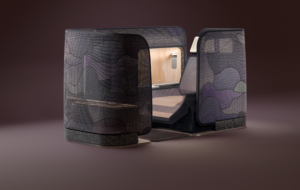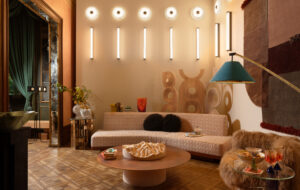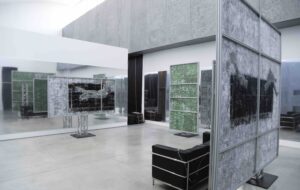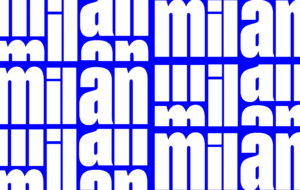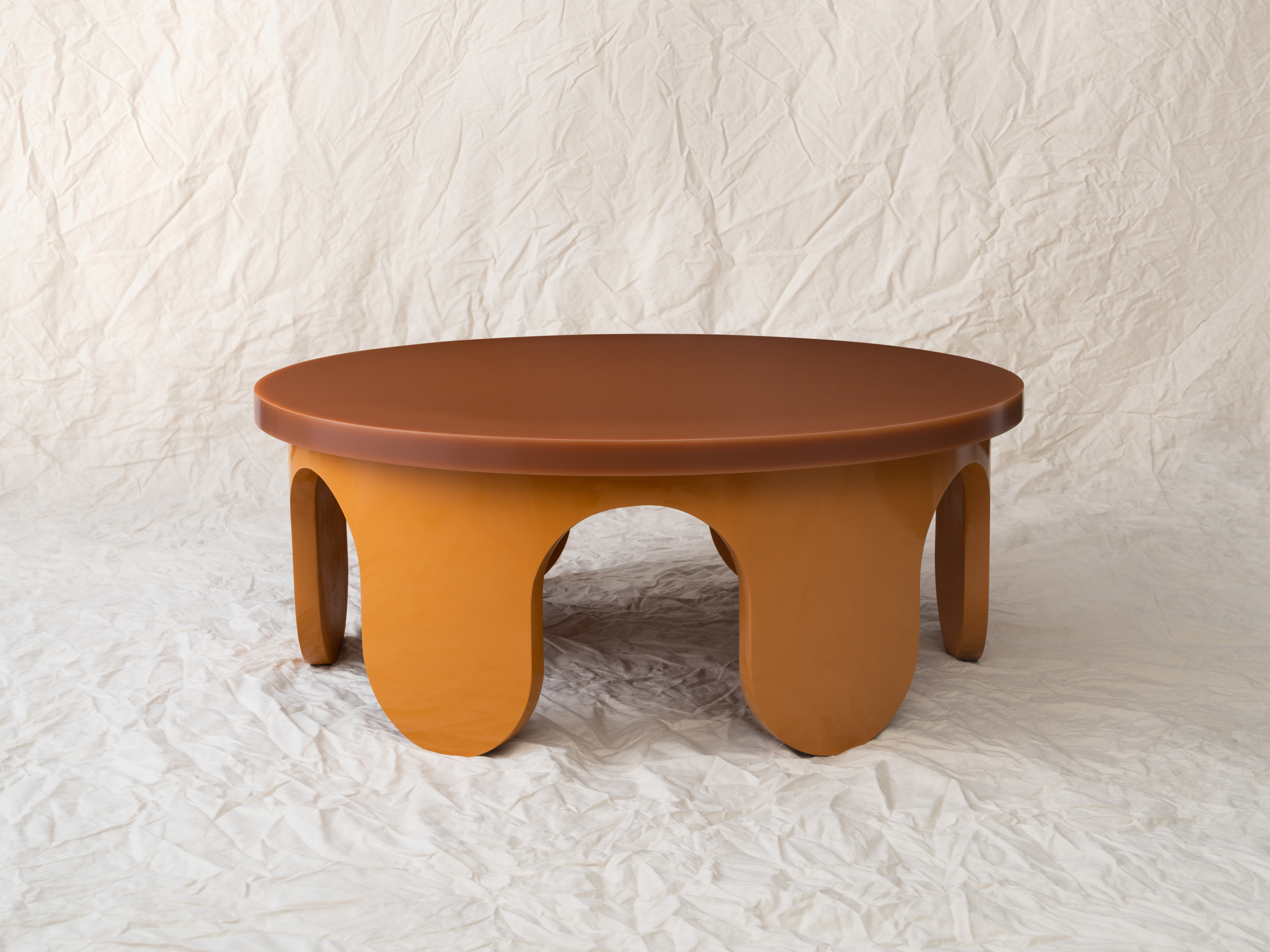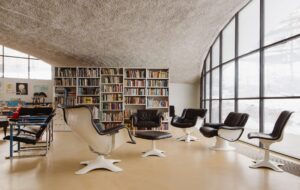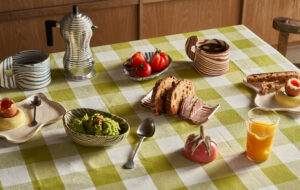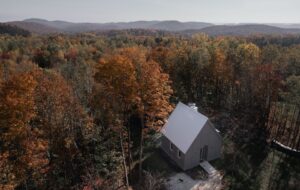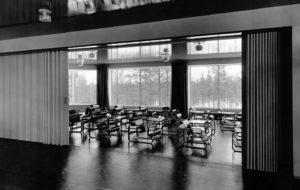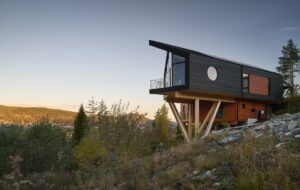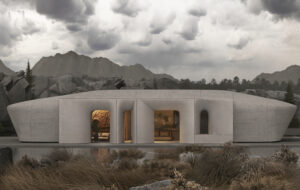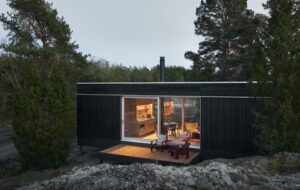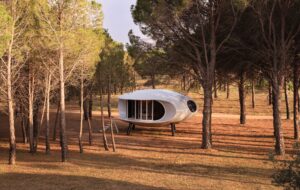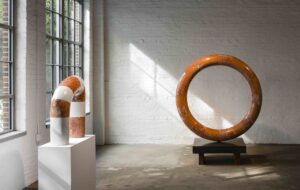
words Kieran Long
At 2.6 km long, the viaduc de millau is Norman Foster’s biggest ever project. And when I got to this small town in southern France, whose western skies are now filled by the seven toothpick-like piers of the bridge, I couldn’t find it.
This was not a problem I had expected to face. The publicity around the viaduct’s inauguration was dominated by statistics: it is the highest bridge in the world at 342m, as high as one and a bit Eiffel Towers. It is also the longest cable-stayed bridge in the world.
The switchback mountain road that descends to the town of Millau has signposted points for cars to stop and take in panoramic views of the region’s latest engineering wonder, but the Tarn Valley was full to the brim with thick fog. Millau, nestled at the bottom of the valley, was cloaked in a January pea-souper, and with visibility at around 10m, the spectacular skyline I had expected was hidden.
“It is often like this at this time of year,” explained the taxi driver who rather quizzically drove me through the fog to the base of the great bridge. “Sometimes it doesn’t lift until the evening.” Great, I thought, a three-hour train and coach journey from the airport had ended with a view of the bases of the piers, the deck all but invisible in the mist, 250m overhead. Even the visitor centre was closed.
To see the valley cloaked in fog was beautiful, and as the morning wore on, the sun gradually reached over the peaks and began to burn away the mist. Initially, the feet of the bridge had looked like strange tree stumps disappearing into a misty canopy. Gradually the concrete structure emerged.
The €400m viaduct forms the final section of the A75 motorway, the main route to the Côte d’Azur for holidaymakers from Paris and the rest of northern France. The roads through Millau to the south coast are jammed for most of August, and a seamless route to France’s holiday Mecca was badly needed. The bridge was funded privately, and a toll of €4.90 (paid at the high-tech toll centre a few kilometres to the north of the bridge) gets you through the 7km section of road of which the bridge is a 2.5km part.
The project had a long period in embryo. The idea for a cable-stayed bridge spanning the valley was in place from the early 1990s, but it was not until a competition was held to find a contractor to build and operate the bridge that its final form was decided. Every bidder was required to have an architect involved, and Foster’s design, with French contractor Eiffage, was selected in 1994.
The project is a testament to an architect working on a huge scale with which he is very comfortable. Many of the other entries attempted to create a viaduct that acknowledged the River Tarn, which lies at the bottom of the valley and measures no more than 20m bank to bank. Rather than hide from, or defer to the natural beauty of the area, Foster grasped the nettle of imposing a new order onto the landscape. The viaduct makes no attempt to acknowledge what Foster has described as “the tiny dribble of a river”, and the seven piers, equally spaced, create their own mathematical and engineering logic, expressed as a man-made piece, embellishing rather than trying to be sympathetic to the landscape.
The concrete structure is on such a scale that it cannot claim to be contextual in any conventional definition. It takes its place as part of a distinguished lineage in the region – nearby is the 1st century BC Pont du Gard aqueduct and the 1886 Viaduc de Garabit by Gustave Eiffel. The engineering traditions of Foster’s native England have also provided long-term inspiration for his steel and glass material palette, and are brought to bear again here.
It is appropriate that this expression of supreme confidence happened in Foster’s beloved France. He now lives there most of the year. And the bridge is just 150km from Nîmes, site of one of his most praised buildings: the Carré d’Art. Carré d’Art is an art gallery, library and multi-use public building in the centre of this Roman town, just down the road from the amphitheatre, and right next door to one of the most complete Roman temples in France, the Maison Carré, built in the 1st century AD. Carré d’Art was praised on its completion for its ability to take a high-tech material palette and make a building that refers explicitly to the classical architecture of the temple opposite it. To this end, it has a kind of loggia and vestibule, but enclosed in glass with steel columns. It has a huge, civic staircase at its heart.
However, to go there now is to see a very successful building, but one where the hype has melted away. It no longer feels very much like it unites the ancient and modern. The references are literal and hardly ground-breaking, approximating elements of the classical temple, but with different materials. It is temple-like, but it is also office-like and mall-like. It appropriates the classical architecture it references, rather than making any profound point about high-tech’s connections with the architecture of Roman classicism.
The bridge’s clear engineering lineage, however, avoids this rather mannered high-tech classicism. It is an iconic diagram. As you can see in the exhibition at the bridge’s visitor centre, compare it in elevation to other great bridges and it stands up as a remarkable and gossamer piece of contemporary engineering. The impossibly slim piers divide elegantly as they meet the deck, creating an effect like a series of giant needles stuck into the ground, their eyes aligned.
There are, of course, proportional games going on here. The height of the pylons (343m from the river level) is almost exactly the same as the spacing of the seven pylons (342m). The height of the highest pylon (240m) is 1/10 the length of the deck (2,460m). But despite these mathematical justifications, the proportions are generated by the horizon line in the valley. Viewed from ground level, the piers reach up to around the height of the surrounding mountains – an optical effect that accentuates the proportions of the valley. The blinking white lights at the tops of the piers continue a visual datum that is begun by the height of the valley peaks. The bridge does, in fact, have an incline of 3° from north to south, but this is almost imperceptible – it appears as a horizontal continuation of the proportions of the surroundings.
The sheer grandeur of conception behind the bridge feels somewhat old-fashioned. Foster does a few simple things with it, such as making a shallow curve in plan that creates a spectacular vista for the motorist of the curving line of pylons. Although the translucent wind breaks on the sides of the bridge preclude a view of the valley for car passengers, the curve makes for a thrilling experience nonetheless.
The design has very different effects depending on your distance from it. On clear days, and from further down the valley, the bridge appears white, and the cables become invisible, leaving just the deck and piers reflecting the sunlight.
The Tarn Valley, and the spectacular mountain road that takes you there from Montpellier on the coast, is prone to inexplicable mists and multi-coloured sunrises. In the valley the sun takes longer to come up, and the mountains are clothed initially in hues of violet and burgundy, with the sky still dark. To watch Foster’s new bridge emerge from this mist is one of the most thrilling architectural experiences you can have. The strength of the project is that it does not try to pretend it is part of this natural landscape. Nor does it attempt to be sculpture. It is a magnificent piece of infrastructure, and one of Foster’s greatest projects.

